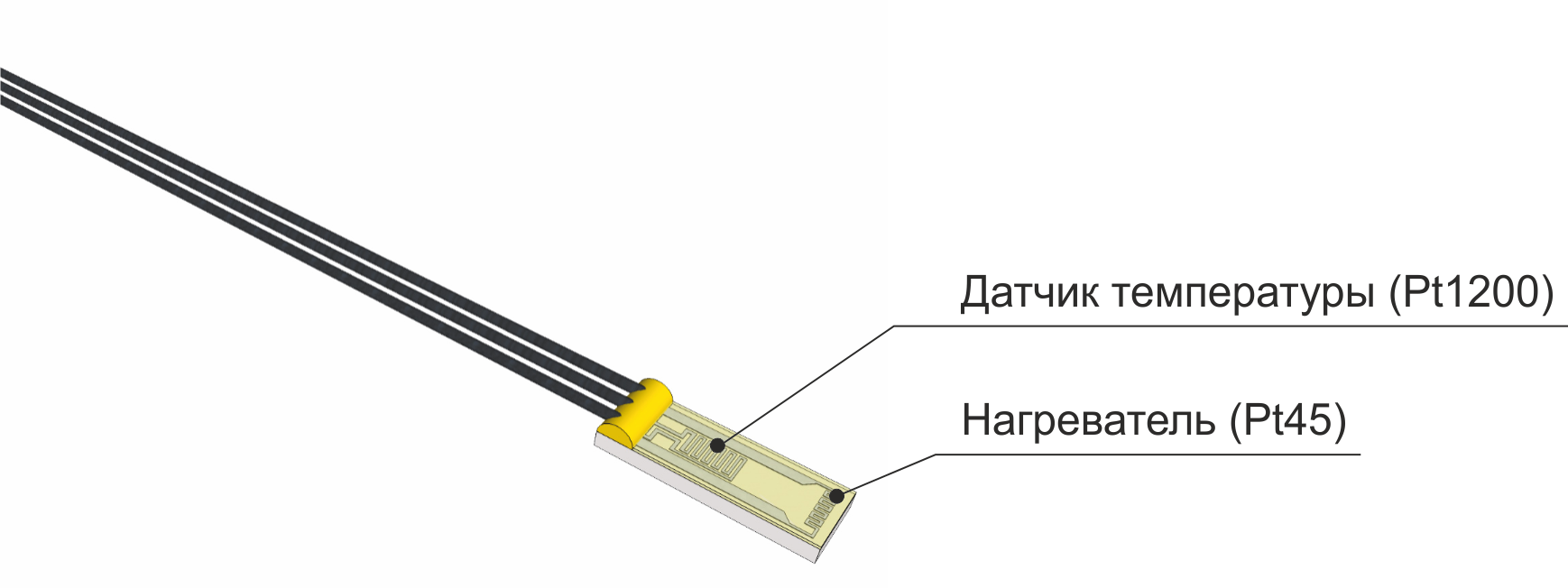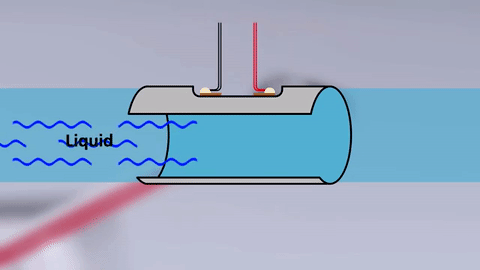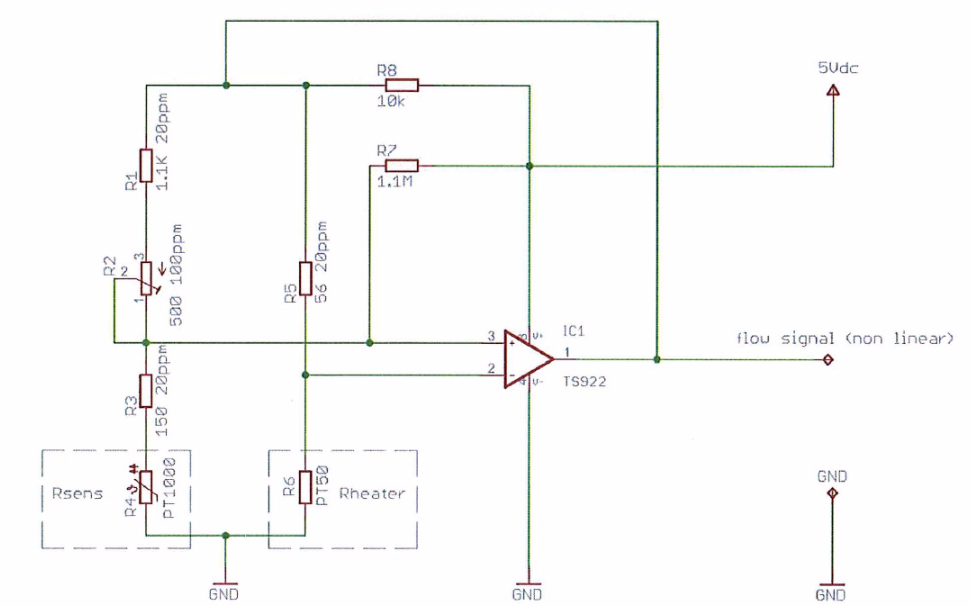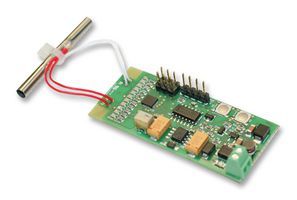We start the flow velocity sensor
The post is dedicated to the Out Of Liquid flow rate sensor - a hot-wire anemometer for measuring the flow of liquid media. Under the cat, the reader will find a description of the principle of operation of the sensor, as well as a video on which this principle is clearly demonstrated.

The element is a small stainless steel tube and is suitable for both water and aggressive liquids and gases.
Recently, an article was published about an FS7 gas flow sensor , today's text can be called its continuation.
')

Let me remind you that FS7 is a miniature ceramic plate measuring 6.9 by 2.4 mm, on which two platinum thermistors (RTD) are applied. One of them has a nominal resistance of 45 ohms and is used as a heater, the other has a nominal resistance of 1200 ohms and serves as a temperature sensor. The first element, respectively, is denoted Pt45, the second - Pt1200.
The sensor is placed in the pipe through which the flow passes, and the elements of Pt45 and Pt1200 are included in the bridge circuit. In the absence of a flow resistance of the heater and temperature sensor do not change, the bridge is balanced. However, when the medium begins to move "past" the sensor, some of the heat from the heater is given off to the flow, i.e. the resistance of the heater (Pt45 element) decreases. At the same time, the resistance of the Pt1200 element remains the same, which means that the bridge will be unbalanced. The imbalance signal depends on the amount of heat given to the heat, which in turn depends on the flow rate.

However, all this is written in much more detail in the previous article , today we will consider the sensor for conditions in which the use of FS7 is not recommended.
FS7 sensors are designed for gases and are also suitable for some liquid media, for example for oils. However, for aggressive liquids, for liquids containing water, and also for aggressive gases, the Out Of Liquid sensor is intended.
Out Of Liquid is the same hot-wire anemometer consisting of two platinum RTDs with a nominal resistance of 50 and 1000 ohms. The Pt50 element plays the role of a heater, and the Pt1000 element plays the role of a medium temperature sensor.

The principal difference of the Out Of Liquid sensor is that thermal resistances do not fit in the medium, as in the case of FS7, but are soldered to the outer wall of the pipe through which the flow goes. Good thermal contact between thermal resistance and medium is achieved due to the small thickness of the pipe wall and due to the design of the Pt50 and Pt1000 elements. These platinum thermistors are, first, made by thin-film technology, which means they have a small size (2.3 x 2 mm) and a flat shape, and second, the bottom side of both elements is covered with an additional metal layer.
The Out Of Liquid tube is made of stainless steel, its length is 40 mm, outer diameter - 4 mm, inner diameter - 3.8 mm. The tube either cuts into the main pipe, or is discharged from it as a shunt, everything depends on the final task.
The final task (dimensions of the pipe, the composition and temperature of the medium, etc.) also determines the choice of components for the sensor switching circuit. For this reason, the manufacturer does not provide detailed guidelines for the use of Out Of Liquid.
Inclusion circuit Out Of Liquid repeats the incorporation scheme of any other thermal anemometer. Pt50 and Pt1000 perform the role of the lower arms of the measuring bridge, the unbalance signal of which is fed to the amplifier, and from there back to the bridge. Thus, in the presence of a flow, the feedback signal informs the heater of a higher temperature and the measuring bridge again balances. The signal at the output of the amplifier, as mentioned above, is also used as an output signal. The value of the output voltage depends nonlinearly on the flow rate through the Out Of Liiquid.
Example of the inclusion scheme:

An example of the dependence of the output voltage on the flow rate [photo from the documentation]:

Out Of Liquid has four outputs, two for each thermal resistance. The Pt50 element has red wires, the Pt1000 is white. It is easy to guess that the flow must go from Pt1000 to Pt50, and not vice versa, otherwise the heat from the heater will go to the temperature sensor and affect its resistance.
By the way, the FS7 element has a heater and a temperature sensor located one under the other, i.e. the flow can be directed both ways relative to the sensing element.
Using the Out Of Liquid sensor, you can measure the flow rate from 0 to 3000 ml / min (≈4 m / s). The operating temperature range of the sensor is from -50 to + 180 ° C, the response time does not exceed 300 ms.
A debugging board is available to familiarize yourself with the Out Of Liquid module, but not for use in the finished product.

In addition to the sensor switching circuit, there are power control circuits, a potentiometer and two buttons for adjusting the resistor R1 (upper arm of the measuring bridge), LEDs for indicating the flow velocity, and contact pads, most of which for some reason hang in the air.

The simple process of switching on the board is shown in the video.
We sell sensors Out Of Liquid at a retail price of 24 euros, meaning retail sales of up to 50 pieces. For bulk purchases, the price naturally decreases, for example, if you order 100 pieces, the price of an item will be 15 euros. By the way, the official name of the sensor Out Of Liquid is the unprovable P1K0 / 050.232.2K.C.050.MUS
I take this opportunity to cite a link to the recently launched efo-sensor.ru site, dedicated to sensors produced by IST-AG and other manufacturers.
In conclusion, I traditionally thank the reader for his attention and remind you that questions about the use of products, about which we write on Habré, can also be asked by email, specified in my profile.
The element is a small stainless steel tube and is suitable for both water and aggressive liquids and gases.
Retreat (about FS7 sensor)
Recently, an article was published about an FS7 gas flow sensor , today's text can be called its continuation.
')

Let me remind you that FS7 is a miniature ceramic plate measuring 6.9 by 2.4 mm, on which two platinum thermistors (RTD) are applied. One of them has a nominal resistance of 45 ohms and is used as a heater, the other has a nominal resistance of 1200 ohms and serves as a temperature sensor. The first element, respectively, is denoted Pt45, the second - Pt1200.
The sensor is placed in the pipe through which the flow passes, and the elements of Pt45 and Pt1200 are included in the bridge circuit. In the absence of a flow resistance of the heater and temperature sensor do not change, the bridge is balanced. However, when the medium begins to move "past" the sensor, some of the heat from the heater is given off to the flow, i.e. the resistance of the heater (Pt45 element) decreases. At the same time, the resistance of the Pt1200 element remains the same, which means that the bridge will be unbalanced. The imbalance signal depends on the amount of heat given to the heat, which in turn depends on the flow rate.
However, all this is written in much more detail in the previous article , today we will consider the sensor for conditions in which the use of FS7 is not recommended.
About Out Of Liquid Sensor
FS7 sensors are designed for gases and are also suitable for some liquid media, for example for oils. However, for aggressive liquids, for liquids containing water, and also for aggressive gases, the Out Of Liquid sensor is intended.
Out Of Liquid is the same hot-wire anemometer consisting of two platinum RTDs with a nominal resistance of 50 and 1000 ohms. The Pt50 element plays the role of a heater, and the Pt1000 element plays the role of a medium temperature sensor.

The principal difference of the Out Of Liquid sensor is that thermal resistances do not fit in the medium, as in the case of FS7, but are soldered to the outer wall of the pipe through which the flow goes. Good thermal contact between thermal resistance and medium is achieved due to the small thickness of the pipe wall and due to the design of the Pt50 and Pt1000 elements. These platinum thermistors are, first, made by thin-film technology, which means they have a small size (2.3 x 2 mm) and a flat shape, and second, the bottom side of both elements is covered with an additional metal layer.
Such metallized thermistors are used separately as temperature sensors. They are in demand in applications where good contact with the surface of the measurement object is required.
The article “ Thermal Resistance: Production Process” is devoted to the production of various platinum thin-film thermistors.
The Out Of Liquid tube is made of stainless steel, its length is 40 mm, outer diameter - 4 mm, inner diameter - 3.8 mm. The tube either cuts into the main pipe, or is discharged from it as a shunt, everything depends on the final task.
The final task (dimensions of the pipe, the composition and temperature of the medium, etc.) also determines the choice of components for the sensor switching circuit. For this reason, the manufacturer does not provide detailed guidelines for the use of Out Of Liquid.
Inclusion circuit Out Of Liquid repeats the incorporation scheme of any other thermal anemometer. Pt50 and Pt1000 perform the role of the lower arms of the measuring bridge, the unbalance signal of which is fed to the amplifier, and from there back to the bridge. Thus, in the presence of a flow, the feedback signal informs the heater of a higher temperature and the measuring bridge again balances. The signal at the output of the amplifier, as mentioned above, is also used as an output signal. The value of the output voltage depends nonlinearly on the flow rate through the Out Of Liiquid.
Example of the inclusion scheme:
An example of the dependence of the output voltage on the flow rate [photo from the documentation]:
Out Of Liquid has four outputs, two for each thermal resistance. The Pt50 element has red wires, the Pt1000 is white. It is easy to guess that the flow must go from Pt1000 to Pt50, and not vice versa, otherwise the heat from the heater will go to the temperature sensor and affect its resistance.
By the way, the FS7 element has a heater and a temperature sensor located one under the other, i.e. the flow can be directed both ways relative to the sensing element.
Using the Out Of Liquid sensor, you can measure the flow rate from 0 to 3000 ml / min (≈4 m / s). The operating temperature range of the sensor is from -50 to + 180 ° C, the response time does not exceed 300 ms.
A debugging board is available to familiarize yourself with the Out Of Liquid module, but not for use in the finished product.

In addition to the sensor switching circuit, there are power control circuits, a potentiometer and two buttons for adjusting the resistor R1 (upper arm of the measuring bridge), LEDs for indicating the flow velocity, and contact pads, most of which for some reason hang in the air.
The simple process of switching on the board is shown in the video.
About prices
We sell sensors Out Of Liquid at a retail price of 24 euros, meaning retail sales of up to 50 pieces. For bulk purchases, the price naturally decreases, for example, if you order 100 pieces, the price of an item will be 15 euros. By the way, the official name of the sensor Out Of Liquid is the unprovable P1K0 / 050.232.2K.C.050.MUS
I take this opportunity to cite a link to the recently launched efo-sensor.ru site, dedicated to sensors produced by IST-AG and other manufacturers.
Conclusion
In conclusion, I traditionally thank the reader for his attention and remind you that questions about the use of products, about which we write on Habré, can also be asked by email, specified in my profile.
Source: https://habr.com/ru/post/325076/
All Articles